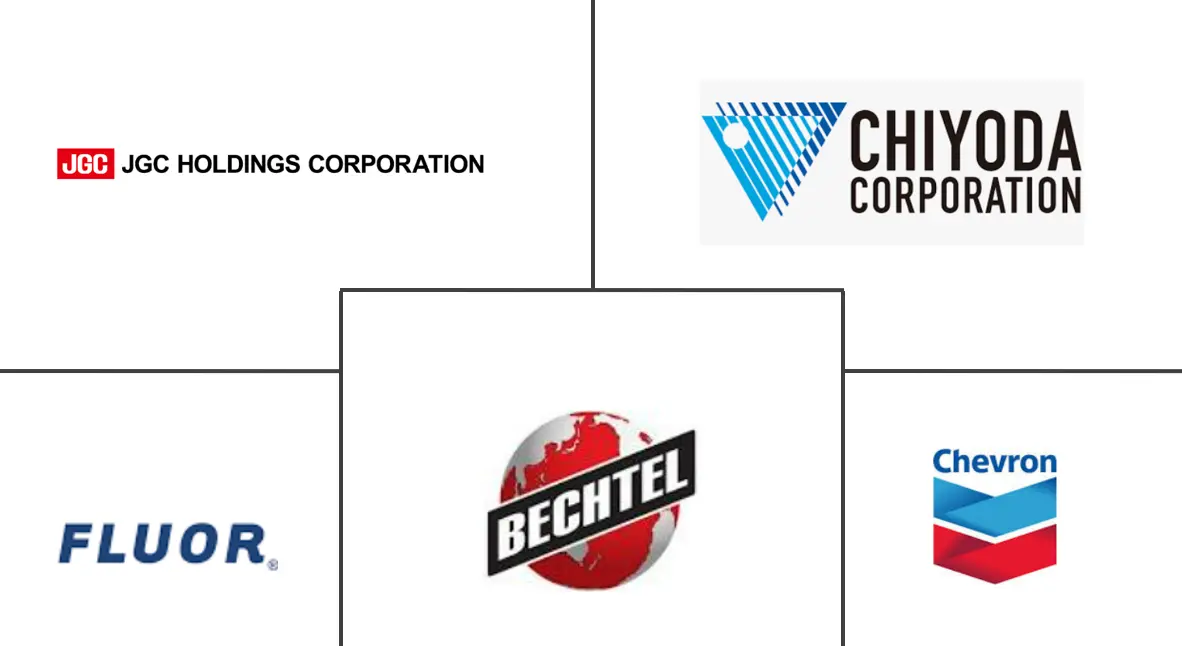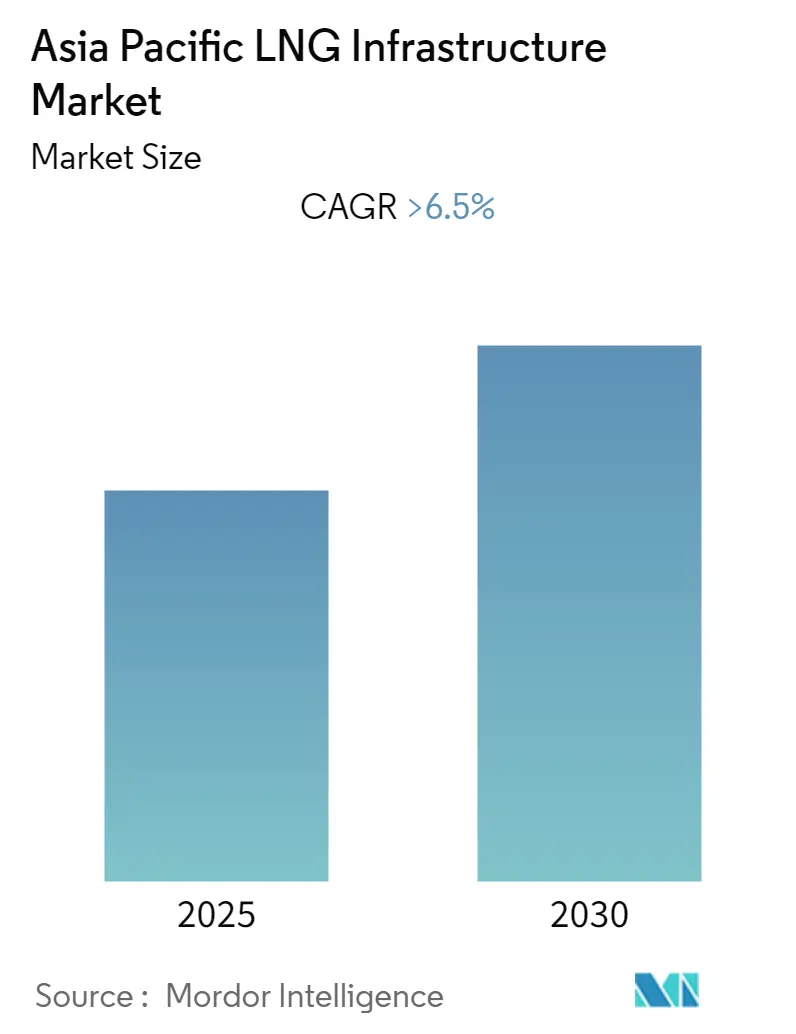
Asia Pacific LNG Infrastructure Market Analysis by Mordor Intelligence
The Asia Pacific LNG Infrastructure Market is expected to register a CAGR of greater than 6.5% during the forecast period.
The market was negatively impacted by COVID-19 in 2020. Presently the market has now reached pre-pandemic levels.
- Increasing demand for LNG in bunkering, road transportation, and off-grid power sectors, along with lower CAPEX requirements for LNG, is expected to drive the growth of the market studied.
- On the other hand, nuclear energy production and renewable technology developments in various regions are major restraints for the market.
- Nevertheless, as per the Energy Information Administration (EIA), non-OECD Asian countries like China, India, Bangladesh, Thailand, and Vietnam are expected to consume 120 billion cubic feet per day (bcf/d) of natural gas by 2050, outpacing regional natural gas production by 50 bcf/d. The supply imbalance in the region is likely to result in increasing dependency on the other regard ions, which is expected to create an excellent opportunity for the market players in the forecast period, as these projects are paving the way for the line pipe industry to grow more.
- China region dominates the market and is also likely to witness the highest CAGR during the forecast period. The LNG import was around 12 million tons in 2020, which increased to 79 million tons in 2021. Due to this surge in demand, China became the world's largest LNG importer, surpassing Japan. The increased demand is due to Chinese LNG buyers signing long-term contracts for more than 20 million tons a year.
Asia Pacific LNG Infrastructure Market Trends and Insights
Regasification terminal Segment to have a Significant Share in the Market
- The regasification terminal segment is expected to have a significant market share during the forecast period. Regasification terminals cover nearly 67% of the total global LNG terminal capacity, with maximum terminal capacity terminals in Asia-Pacific.
- Gas can be transported as liquified natural gas for long-distance transport or in situations without access to natural gas pipes. Due to its volume being reduced by around 600 times compared to a gaseous state, natural gas is frequently transported and stored in a liquid form. The gas condenses and turns into a liquid when it is cooled to about -162°C. Regasification is the process of heating a liquified gas to return it to its gaseous condition.
- Many city gas distribution companies in India plan to develop CNG or satellite stations. Moreover, the Government of India plans to add fueling stations along its 6,000-km-long golden quadrilateral highways to build an effective ecosystem for LNG-fueled vehicles. This will likely increase the demand for LNG regasification terminals to ensure an uninterrupted gas supply for transportation applications.
- Natural gas LNG importr in Asia pacific grew from 226.6 billion cubic metres in 2012 to 371.8 billion cubic metres in 2021, a 6% increases.
- Hence, owing to the above points, increasing investment in LNG infrastructure will drive the market during the forecast period.
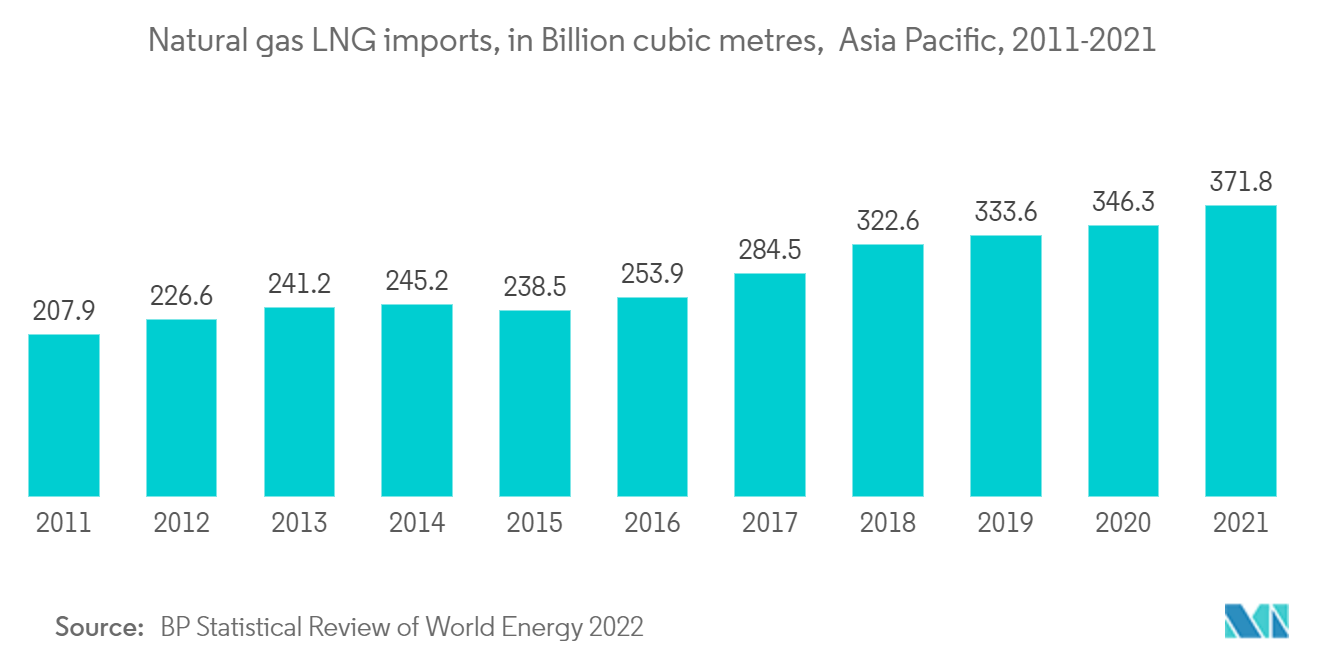
China fastest growing region in the LNG infrastructure market
- In 2021, China is one of the major countries in the world, which led to the growth in LNG demand. In 2020, there were about 94 billion cubic metres tons of natural gas LNG imported; in 2021, there were 109.5 billion cubic metres tons. China surpassed Japan to become the world's biggest LNG importer as a result of this spike in demand. Due to Chinese LNG purchasers signing long-term contracts for more than 20 million tons annually, demand has surged.
- Increasing demand for LNG is from industrial, residential, and power generation sectors, with the highest potential in the transportation sector. In 2020, China had around 113 thousand units of LNG trucks. With a growing focus on having an alternate low carbon emission fuel for heavy truck transportation, LNG as a fuel would be the best substitute for diesel-fueled engines. Growth in the number of LNG trucks due to the higher price of diesel, as compared to natural gas, and increasing investment in LNG infrastructure will drive the market during the forecast period.
- In December 2021, Pavilion Energy, a Singapore-based energy solutions provider, and Zhejiang Hangjiaxin Clean Energy entered a deal to supply a small-scale LNG under which the former company is expected to provide 0.5 million tons per year of LNG to Hangjiaxin from 2023.
- With the increasing adoption of natural gas over coal for power generation, prominent players and small power project companies with no access to remote locations or pipeline facilities are expected to import LNG. They have been showing interest by investing in LNG facilities. The LNG receiving terminals in China are expected to increase with the growing share of LNG in the power sector. Several small power plants near the Yangtze River import LNG directly from small vessels and use them for power generation. China is anticipated to import about 25 MTPA of LNG by 2030.
- Natural gas LNG imported in China from 2012 to 2021 is 20.1 billion cubic metres to 109.5 billion cubic metres i.e 20.6% increases.
- Hence, owing to the above points, China is expected to see significant growth in the LNG infrastructure market during the forecast period.
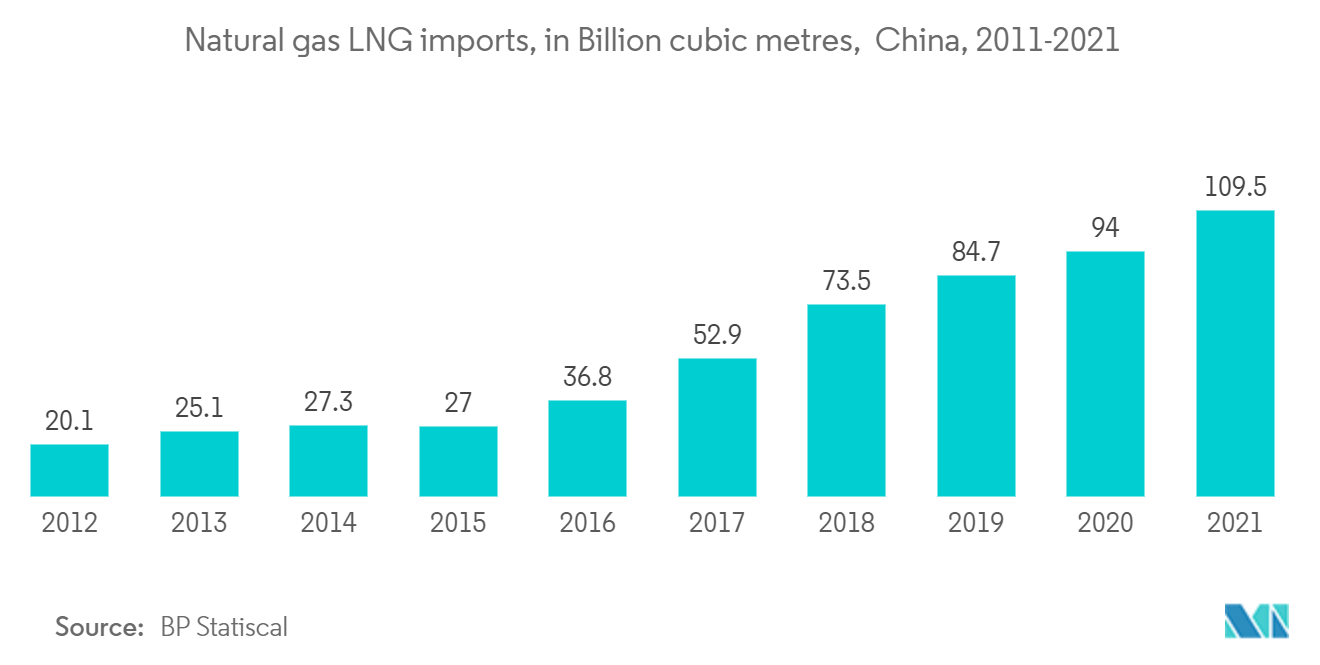
Competitive Landscape
The Asia Pacific LNG infrastructure market is fragmented. Some of the key players in this market (in no particular order) include JGC Holdings Corporation, Chiyoda Corporation, Bechtel Corporation, Fluor Corporation, and Chevron corporation.
Asia Pacific LNG Infrastructure Industry Leaders
-
JGC Holdings Corporation
-
Chiyoda Corporation
-
Bechtel Corporation
-
Fluor Corporation
-
Chevron corporation
- *Disclaimer: Major Players sorted in no particular order
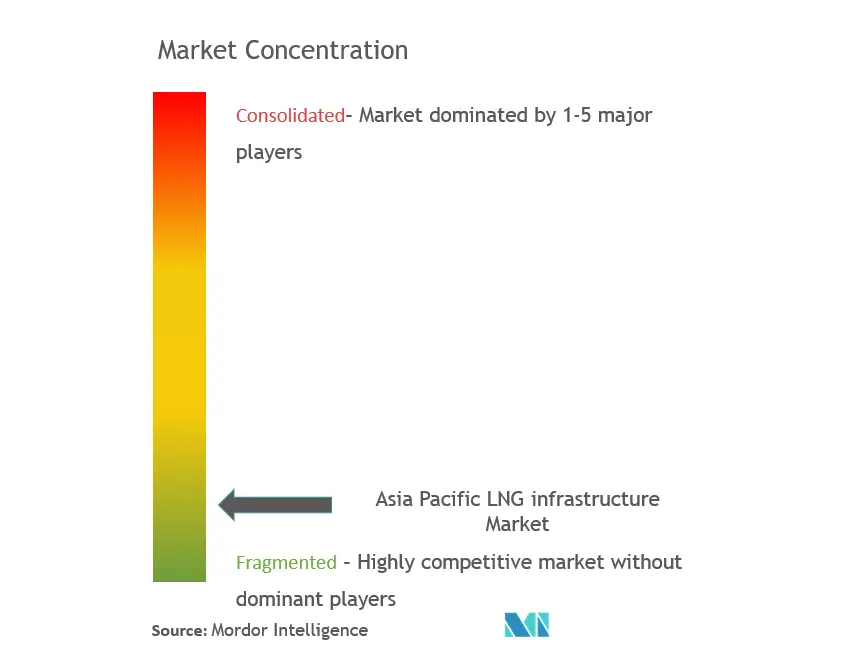
Recent Industry Developments
- In June 2022, NOVATEK signed small-scale LNG cooperation agreements with the Moscow and Samara region's government, as part of the St. Petersburg International Economic Forum. The parties are looking to expand the use of LNG as motor fuel and for gas supply to off-grid customers, including the construction of small-scale LNG plants and relevant sales infrastructure.
- In April 2021, INOXCVA, an Indian multinational cryogenic liquid storage, distribution, and re-gas solutions provider, signed a memorandum of understanding (MOU) with the Japanese conglomerate, Mitsui & Co. (Asia Pacific) Pte. Ltd, for establishing a virtual pipeline in India and deploying small-scale LNG infrastructure, including logistics and receiving facilities at the customer's end, to provide access to LNG.
Asia Pacific LNG Infrastructure Market Report Scope
LNG is natural gas that has been cooled to a liquid state, at about -260° Fahrenheit, for shipping and storage. The volume of natural gas in its liquid state is about 600 times smaller than its volume in its gaseous state. This process makes it possible to transport natural gas to places pipelines do not reach. The LNG infrastructure market is segmented by type and region. By type, the market is segmented into regasification terminals and liquefication terminals. The report also covers the market size and forecasts for the LNG infrastructure market across major countries. for each segment, the market sizing and forecasts have been done based on revenue (USD billion).
| Regasification Terminal |
| Liquefication Terminal |
| India |
| China |
| Japan |
| Australia |
| South Korea |
| Rest of Asia Pacific |
| Type | Regasification Terminal |
| Liquefication Terminal | |
| Geography | India |
| China | |
| Japan | |
| Australia | |
| South Korea | |
| Rest of Asia Pacific |
Key Questions Answered in the Report
What is the current Asia Pacific LNG Infrastructure Market size?
The Asia Pacific LNG Infrastructure Market is projected to register a CAGR of greater than 6.5% during the forecast period (2025-2030)
Who are the key players in Asia Pacific LNG Infrastructure Market?
JGC Holdings Corporation, Chiyoda Corporation, Bechtel Corporation, Fluor Corporation and Chevron corporation are the major companies operating in the Asia Pacific LNG Infrastructure Market.
What years does this Asia Pacific LNG Infrastructure Market cover?
The report covers the Asia Pacific LNG Infrastructure Market historical market size for years: 2020, 2021, 2022, 2023 and 2024. The report also forecasts the Asia Pacific LNG Infrastructure Market size for years: 2025, 2026, 2027, 2028, 2029 and 2030.
Page last updated on:
Asia Pacific LNG Infrastructure Market Report
Statistics for the 2025 Asia Pacific LNG Infrastructure market share, size and revenue growth rate, created by Mordor Intelligence™ Industry Reports. Asia Pacific LNG Infrastructure analysis includes a market forecast outlook for 2025 to 2030 and historical overview. Get a sample of this industry analysis as a free report PDF download.
